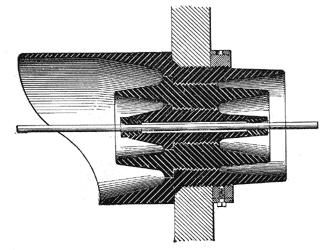[Trade Journal]
Publication: Electrical World
New York, NY, United States
vol. 53, no. 1, p. 72, col. 1-2
New Types of High-Tension Insulators.
The accompanying illustrations show three types of high-tension insulators for which patents have been issued to Mr. Louis Sternberger [sic] Steinberger, and which are claimed practically to cover the entire field of application of- insulators to the transmission of electric power up to the highest voltage that now appears will be reached in the future. In the design of the flexible suspension type shown, provision is made not only for insulating the conductor, but also for insulating the cross-arm or support, which in effect insulates the insulator. Owing to the flexibility of this structure all direct strain on the insulating material is avoided. The dead weight of the conductor, including snow or sleet and the effect of wind-pressure, is supported by insulating material which -is wholly under compression. The form of the metal suspension members makes it quite impossible for the line to drop, even though the, insulating material were totally destroyed.
 |
| Fig. 1 and 2.—Suspension and Disk Strain Insulator. |
The disk type of strain insulator shown provides large interrupted insulating surfaces for limiting surface leakage, while the design prevents moisture, soot or dust from forming a continuous conducting path extending from- one strain member to the other over the surface of the insulator. The form of the strain members and their relation to each other and to the insulating disk are such as to provide an insulator of exceptionally great mechanical strength combined with the highest form of electrical insulation. This disk type of strain insulator may be aged separately, or a number of them may be linked together for supporting a line or used in any other desired relation where currents of very high potential are employed.
 |
| Fig. 3.—Wall Insulator. |
In the wall or barrier insulator shown, the several sections of which the bushing may be composed are separable; should either of the parts become injured or destroyed, it may readily be removed and a new section put in place, thereby avoiding the loss of the entire bushing. It will, of course, be evident that either one of the several bushings may be made of any predetermined length. The bushing is provided with a "protector" which shields the exposed parts from rain, snow, sleet,. etc., and which may be made integral with the bushing or attached separately thereto. The central bushing is provided with detachable members for supporting the line centrally with relation to the bushing„ By 'means of these members the central bushing may be made watertight, thereby maintaining at all times a dry surface within the bushing. Finally, an insulating locking member is provided for securing the bushing relatively to the wall or barrier, thereby obviating the trouble and expense incident to cementing a bushing into place or removing it. These bushings may be mounted into or removed from the wall very readily.
The insulators described are now being manufactured by the Electrose Manufacturing Company, Brooklyn, N. Y.
